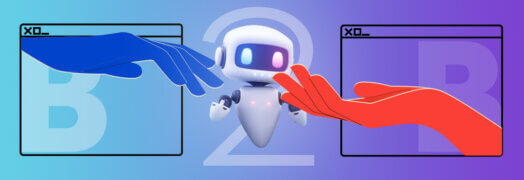Web design is such an exciting industry to be a part of, especially when you get to see innovative, lovely designs. While there are a vast amount of beautiful, functional websites, there are also a ton of ugly, overdone, useless websites.
As a B2B web design and marketing agency, we’ve compiled a list of best web design practices to ensure web designers are creating functional, useful websites.
1. Focus on Your Target Audience
It can be easy to get caught up in the concept of a website and forget about the end user. A successful website isn’t just a lovely visual piece, it’s a portal for attracting your target audience and giving them the information they need to decide if they want to become a new client.
Before we start a new B2B web design, we get the low-down on the target audience.
- Do they know the company’s brand or services?
- Are there several different target markets?
- What makes them the same or different?
- What do they care about?
A common mistake we see designers make is focusing on the target audience at the beginning and then forgetting about them at the end of the design phase. Always keep your target audience front and center, even when making changes to the design, layout and images.
2. Keep Branding Consistent
Website design that lacks consistent branding is stressful and confusing. Everyone has a friend or family member who is unpredictable. You never know what they are going to say/do/wear and they are stressful to be around. Unfortunately, there are quite a few brand websites out there who are like this unpredictable person. It’s difficult to tell what their brand colors are, what their logo looks like, how they are positioning themselves and what their value proposition is all about.
A best practice in B2C and B2B website design is to keep the branding consistent throughout the entire site. Only use the predetermined brand colors, logos, and messaging on every single page of the website. This applies to images, iconography, typography, and videos as well. A brand’s story should be evident and supported in the design.
3. Simplify The Layout
In our recent blog on How Web Design Evolved in 2016, we discussed how simplicity is becoming more and more prominent in web design. Flashy, complicated websites typically deliver a poor experience and end up being visually noisy. Effective websites often have simplified layouts that are easy to navigate and enable each design element to shine. As experienced B2B web designers, we understand that a website typically has to accomplish a lot and host a great deal of information – which can be done in a clean, focused and ultimately simplified manner. If too many design elements are competing on a website, none of them will do their job (engage the user).
4. Create Strong CTAs
The main goal of a website is to attract a target market. The next goal may be to educate the visitor. The final goal should always be to entice the visitor to complete an action, whether it is to sign up for a newsletter, download a case study, or set up a consultation. Strong calls-to-action are essential to converting website visitors into leads or new clients.
Strong CTAs should be part of the initial B2B web design, not an afterthought. They should be placed in an appropriate place in the layout that makes sense for the target market. For example, a “Learn More” button may be placed higher in the design, while a “Contact Us” form may be placed towards the bottom of the design when the visitor is more educated about a brand or company.
5. Use High Quality Images or Videos
Smartphones now have 16, 20, or even 21 mega-pixel cameras in them. Remember, a phone’s main function is not necessarily as a camera. For this very reason, it’s imperative that all images, videos, and photos included in a web design are high quality. A fuzzy image or out-of-focus picture negatively impacts the credibility of a brand.
If your brand or firm isn’t able to invest in custom photography at this time, stock photography is actually a great option these days.
Great web designers balance clear, high-quality images with sizes that don’t slow down the website load time.
6. Enhance the User Experience
At it’s very core, web design must be functional. This means that it should create a good user experience. Effective web design takes it a step further and enhances the user experience by creating an intuitive layout, telling a compelling story, and serving up what the user is looking for when they want to see it. For this very reason, seasoned web designers are taking an interest in the user experience (UX) to ensure their designs are anticipating the needs of the target market.
When looking to enhance the user experience, it’s important for a designer to put themselves in the user’s shoes. Also, it’s essential that the web designer considers how every element of the design builds value for the user and meets a need.
7. Follow SEO Best Practices
If a website is gorgeous but no one sees it, is it effective? The answer is no. Strong websites attract and convert visitors. For this very reason, B2C and B2B web design must follow SEO best practices to ensure the website is showing up for the target market.
While the list of SEO best practices for web design can be fairly long, a few best practices include:
- Sizing pictures for faster load times
- Internal linking to keep users engaged & on the site
- Properly labeling images for search engines and users
At the End of the Day
At the end of the day, B2B web design can be innovative, interesting, and beautiful – but it also needs to be functional. Successful websites don’t need to have boring designs, but they do have to marry smart design with a great user experience.
What do you think is a web design best practice? Let us know in the comments below.



